Holidays in Egypt - One World Tours
Click here
to return to the One World Tours Website
|

Tailor made 5 Day Tour Inc Cairo, Aswan (brief),
Cruise to Luxor. (with internal flights Sharm to Cairo and Luxor to
Sharm)
(Ref : TM5STSHARM)
|
DAY |
SUGGESTED ITIN |
ACCOMMODATION |
|
|
1 |
Early morning flight to Cairo (from Sharm)
Saqarra (Step Pyramid)
Visit The Pyramids / Sphinx
Egyptian Museum (Mask of King Tut is here along with thousands of
other items)
Overnight Train to Aswan |
Overnight train to Aswan |
 |
|
2 |
Felucca sailing around Kitcheners and Elephantine Islands
Board cruise ship to begin cruise to Luxor |
Night on Cruise Ship |
 |
|
3 |
Cruise to Luxor Continues |
Night on Cruise Ship |
 |
|
4 |
Arrive Luxor
Free time at leisure - Take a walk along the corniche - explore
the many small shops and bazaars
Sound and Light Show (at Karnak Temple) |
Hotel - Luxor |
 |
|
5 |
Valley of Kings
Valley of Queens
Hatchpsut Temple
Colossi of Memnon
Early evening Flight to Sharm |
|
 |
Pricing and Details
(Prices quoted based on 2 persons sharing a double
room. Prices in UK sterling)
|
TOTAL TOUR PRICE...... |
|
1 & 2 Star |
3 & 4 Star |
5 Star |
|
£ 430 per person
 |
£510 per person
 |
£719 per person
 |
|
Click
here for Currency Conversion |
|
Tour Includes :-
- All accommodation.
- Transfers (to and from Sharm El Sheikh Intl airport, Luxor
Airport & train stations).
- Transportation (to and from all sites and destinations).
- 1st Class Train Tickets.
- Cruise.
- Internal Flights
- English Speaking Guide.
- Most hotel stays include breakfast.
- Cruise includes all meals.
Items not included :-
- International Flights (See the flights section of this site
or contact us for advice on obtaining flights).
- Entrance fees to sites (most sites are around £2-3. A
full list is available on the "What to See" section of
this site).
- Egyptian Visa (Download a visa application in the visa
section of this site or contact us for information on obtaining
your visa).
Tour Notes
- Dates : All of our tours are
run to fit clients exact date / time requirements. Just let us
know what you require and the tour will be scheduled to fit it
with you.
- Single Supplement: For clients
travelling alone, tours will be subject to a single supplement -
please contact us for further details
- Trains : on 1/2 and 3/4 star packages, overnight
train accommodation is a reclining aircraft style seat - which
is upgradable on request (in advance or on arrival) to a
private sleeper cabin. 5 Star packages
include Private Sleeper Cabins for all overnight train journeys.
|
|
|
|
holidays in egypt, egypt holidays, holidays in egypt, egypt holidays,
holidays in
egypt egypt
holidays holidays in egypt, egypt holidays excursionsto from sharm
cairo luxor aswan cruise
Cairo
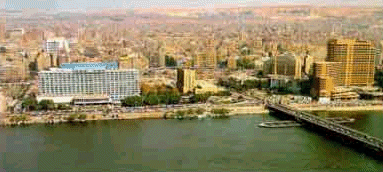
Cairo, and the area around it are considered to be the heart of Egypt,
and one may find almost every aspect of Egypt represented in the area,
including some of the most famous Pharaonic, ancient Christian and Islamic
monuments. Cairo offers an incredible selection of shopping, leisure,
culture and nightlife. Shopping ranges from the famous Khan el-Khalili
souk, (or bazaar) largely unchanged since the 14th century, to modern
air-conditioned centers displaying the latest fashions. All the bounty of
the East is here - particularly good buys are spices, perfumes, gold,
silver, carpets, brass and copperware, leatherwork, glass, ceramics and
mashrabiya. Try some of the famous street markets, like Wekala al-Balaq,
for fabrics, including Egyptian cotton, the Tentmakers Bazaar for appliqué-work,
Mohammed Ali Street for musical instruments and, although you probably
won't want to buy, the Camel Market makes a fascinating trip.
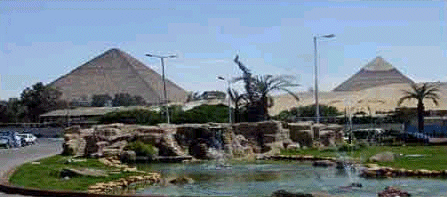
When you need a break from city life, try a round of golf on the famous
Mena House course overlooking the Pyramids, watch the horse racing at the
Gezira Club or visit the Zoo and the Botanical Gardens. Take a trip on the
Nile in a felucca or ride on horseback from the Giza Pyramids to Sakkara.
For a day trip outside Cairo visit Haraniyya village and see the beautiful
tapestries and weaving produced by local people. If you wish, you may get
away from it all at the top of the Cairo Tower, a modern 187 meter-high
tower with views of the city from all sides, topped by a revolving
restaurant.
Cairo comes alive at night, which is the best time to shop, eat
delicious Middle Eastern cuisine, or simply watch the world go by from a
pavement cafe. You can dine in a floating restaurant on the Nile, sample
an apple-flavored shisha waterpipe at a coffee-shop or see oriental
dancers and cabarets at a luxury hotel. The splendid Opera House complex
houses several galleries (including the Museum of Modern Art), restaurants
and concert halls. Listening to Arabic music under the stars, in the
open-air theater, is a magical experience. At El-Ghuriya, in the heart of
Islamic Cairo you can watch folk musicians and whirling dervish dancers.
And don't forget the most essential after-dark experience, the Sound and
Light show at the Pyramids, a dramatic fusion of light and music
recounting the story of antiquity.
Islamic Cairo is not the oldest section of Cairo, as that distinction
belongs to Old Cairo. Westerners visiting Cairo many not wish to think in
terms of Islamic here, but rather medieval. Indeed this area encompasses
the medieval history from beginning to end.
Old Cairo actually predates Cairo itself to old Babylon and the Romans.
Located here are some of the oldest Christian Churches in the World, as
well as one of the oldest Mosques.
Giza is where the Great Pyramid is located, but there is more to the
west bank of the Nile. Several important districts are located here, along
with wonderful restaurants and great shopping opportunities.
Hurghada

Hurghada was founded in the early 20th century, and until a few years
ago, remained a small fishing village. But today, it has gone on to become
the foremost tourist resort of the Red Sea coast and an international
center for aquatic sports. If it takes place in or on the water you can do
it here : windsurfing, sailing, deep-sea fishing, swimming, but, above
all, snorkeling and diving. The unique underwater gardens offshore are
some of the finest in the world, justifiably famous amongst divers. The
warm waters here are ideal for many varieties of rare fish and coral
reefs, which may also be observed through glass bottom boats. This area
has many fine accommodations, usually offering warm and efficient service.
Restaurants are mostly along the main road. While in Hurghada, don't miss
the museum and aquarium, with their complete collections of flora and
fauna of the Red Sea.
Today, Hurghada is known as a party town, particularly among Europeans.
Locals and others will tell you that life begins at night in Hurghada,
with the many, many clubs. They are particularly frequented by the young,
but certainly many others of all ages. One may often find a rousing party
centered around the visitors from a tour group taking over the action of a
particular bar. They are easy to find along the main street, along with
loads of inexpensive and expensive hotels.
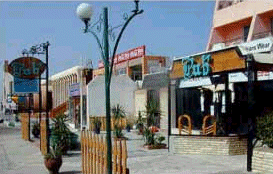
It is also a beach resort, where thousands of older Europeans and others
come with their families to enjoy the sun and fun of private resort
beaches, some all inclusive. Many of these hotels offer so many activities
and facilities that one may never need to leave the resort. Often, the
larger resorts have zoos, playgrounds, discos, bars, a number of pools and
even small theaters.
Hurghada is also a city under development. Many new hotels and
construction are taking place, and we can expect to see some great new
hotels, restaurants and other facilities in the near future. Actually this
is a busy section of the Red Sea in general. Safaga is just south of
Hurghada, and Soma Bay with its beautiful Sheraton is even closer to the
South. To the North is El Gouna, a highly organized resort community.
Together, these communities and resort areas offer just about everything a
visitor might wish for, from raucous parties to isolated scuba diving,
with golf, bowling and fishing in between.
Islands near Hurghada offer all kinds of fun and excitement. Take a day
trip to Giftun Island for snorkeling and a fish barbecue, or view the Red
Sea from a submarine! When you're not in the sea you can shop in the
boutiques, relax in the luxury holiday villages or visit the Roman Mons
Porphyrites (mountain of porphyry) remains at nearby Gebel Abu Dukhan
(Father of Smoke). Day-trips or safaris to explore the Red Sea Mountains
by camel or jeep are also available. Other nearby islands and destinations
include the Shadwan Island (Diving, snorkeling, fishing but no swimming),
Shaab Abu Shiban (Diving, snorkeling and swimming), Shaab el-Erg (Diving,
fishing and snorkeling), Umm Gammar Island (Diving and snorkeling), Shasb
Saghir Umm Gammae (Diving), Careless Reef (Diving), Abu Ramada Island
(Diving), Shaab Abu Ramada (Fishing), Dishet el-Dhaba (Beaches and
swimming), Shaab Abu Hashish (Beaches, diving, snorkeling, swimming and
fishing), Sharm el-Arab (Diving, swimming and fishing and Abu Minqar
Island (Beaches and swimming).
Sharm el Sheikh
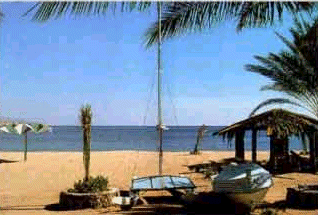
The simplicity of sun, sea and sand. The luxury of five-star hotels,
water sports, shopping and entertainment. This is Sharm el-Sheikh, one of
the most accessible and developed tourist resort communities on the Sinai
peninsula. All around are Bedouins, colorful tents, mountains and sea.
There are small, intimate hotels with modern designs, as well as larger
hotel complexes belonging to International chains, plus about all the
amenities one could expect of a tourist center, including casinos, discos
and nightclubs, golf courses and health facilities.
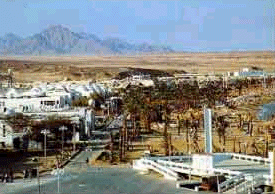
In fact, with diving and snorkeling, windsurfing and other water sports,
horses and camel riding, desert safaris, and great nearby antiquities
attractions, it is almost impossible for a visitor to ever suffer from
boredom.
Four miles south the southern section of the town stands on a cliff
overlooking the port. and is a great view.
Na'ama Beach is one of the center of the tourist activities. Located
just north of Sharm, this area is developing into a resort town of its
own. Most hotels at Na'ama Bay have their own, private beaches with
comfortable amenities such as chairs, shades and even bars.
Shark's Bay is also nearby, and again is a growing resort community with
more and more to offer, along with several diving centers.
The small harbor known as Sharm el-Moiya is located next to the civil
harbor, has accommodations for boats, and includes a Yacht Club with
rooms.
For those who live to shop, the Sharm el-Sheikh mall provides shops with
both foreign and local products, including jewelry, leather goods,
clothing, pottery and books.
It has been said that this is a must visit for all diving enthusiasts.
There are many diving sites along the 10 mile beach between Sharm
el-Sheikh and Ras Nusrani.
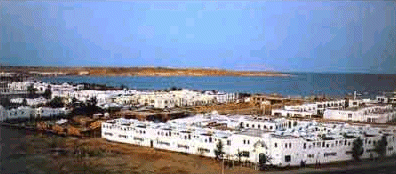
The City of Aswan
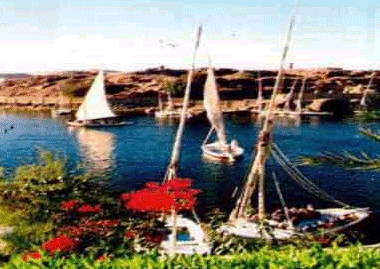
Aswan, Egypt's sunniest southern city and ancient frontier town located
about 81 miles south of Luxor, has a distinctively African atmosphere. Its
ancient Egyptian name was Syene. Small enough to walk around and graced
with the most beautiful setting on the Nile, the pace of life is slow and
relaxing. Days can be spent strolling up and down the broad Corniche
watching the sailboats etch the sky with their tall masts or sitting in
floating restaurants listening to Nubian music and eating freshly caught
fish.
In Aswan the Nile is at its most beautiful, flowing through amber desert
and granite rocks, round emerald islands covered in palm groves and
tropical plants. Explore the souk, full of the scent and color of spices,
perfumes, scarves and baskets. View the spectacular sunsets while having
tea on the terrace of the Old Cataract Hotel (Named due to the location of
the Nile's first cataract located here). Aswan has been a favorite winter
resort since the beginning of the nineteenth century, and it's still a
perfect place to get away from it all.
Every night Nubian dancers and musicians perform in the Cultural Center,
just off the Corniche. Folklore troupes recreate scenes from village life
and perform the famous Nubian mock stick-fight dances.

Aswan is a strategic location which currently houses a garrison of the
Egyptian army, but which has also seen ancient Egyptian garrisons, as well
as that of General Kitchener, Turkish troops of the Ottoman empire and the
Romans. The city proper lies on the east bank of the Nile. Relax here,
visit a few mosques, but then prepare for an adventure. The bazaar runs
along the Corniche, which continues past the Ferial Gardens and the Nubian
Museum, and continues on to the Cemetery, with its forest of cupolas
surmounted tombs from the Fatimid period. Just east of the cemetery in the
famous area quarries is the gigantic Unfinished Obelisk. Just to the south
of this, two Graeco-Roman sarcophagi and an unfinished colossus remain
half buried in the sand.
The most obvious is Elephantine Island, which is timeless with artifacts
dating from pre-Dynastic times onward. It is the largest island in the
area. Just beyond Elephantine is Kitchener's Island (Geziret el-Nabatat).
It was named for the British general Haratio Kitchener (185--1916) and was
sent to Egypt in 1883 to reorganize the Egyptian army, which he then led
against the Sudanese Mahdi. But the island is known for its garden and the
exotic plants the Kitchener planted there, and which continue to flourish
today.
On the opposite shore (west bank), the cliffs are surmounted by the tomb
of a marabut, Qubbet el-Hawwa, who was a local saint. Below are tombs of
the local (pharaonic) nobles and dignitaries.
Upriver a bit is the tomb of Mohammed Shah Aga Khan who died in 1957.
Known as the Tomb of the Aga Khan, it is beautiful in its simplicity. A
road from there leads back to the Coptic Monastery of St Simeon, which was
built in the sixth century in honor of Amba Hadra, a local saint.
Just up river a bit, there is also the old Aswan dam, built by the
British, which was enlarged, expanded, but unable to control the Nile for
irrigation.
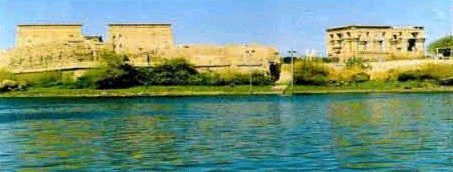
Luxor / Karnak / Thebes
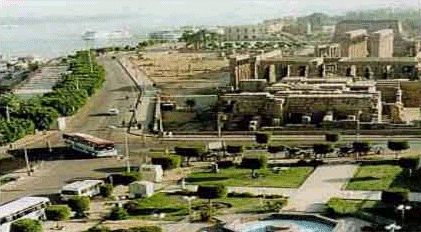
Luxor has often been called the worlds greatest open air museum, as
indeed it is and much more. The number and preservation of the monuments
in the Luxor area are unparalleled anywhere else in the world that know
of. Actually, what most people think of as Luxor is really three different
areas, consisting of the City of Luxor on the East side of the Nile, the
town of Karnak just north of Luxor and Thebes, which the ancient Egyptians
called Waset, which is on the west side of the Nile across from Luxor.
To say that the Luxor area is a major attraction for tourists in Egypt
would be an understatement. It has been a tourist destination since the
beginning of tourism. Even in ancient times, during the late Dynasties of
the Greek and Roman periods, the area drew tourists, and has been doing so
ever since. Today Luxor is well equipped to accommodate tourists with many
hotels and in general a tourist industry ready and willing to serve the
people from many countries that descend on this area of the Nile Valley
every year. Within Luxor, there are only three main streets consisting of
Sharia al-Mahatta, Sharia al-Karnak and the Corniched, next to the Nile.
The street in front of the train station is Sharia al-Mahatta and runs
away from the Nile where it meets the gardens of Luxor Temple. Sharia
al-Karnak, or Maabad al-Karnak which means Karnak Temple Street runs along
the Nile from Luxor Temple to Karnak Temple. However, Sharia al-Karnak is
known as Sharia al-Markaz where it meets Sharia al-Mahatta street, and to
the south around the temple it is known as Sharia al-Lokanda. Along this
street one will find the colorful signs of restaurants and cafes, as well
as bazaars where the usual variety of Egyptian souvenirs can be found. Of
interest is the alabaster, which is plentiful along the west bank and
miled not far from here. Also look for the clay pots used by the locals
for cooking, which are more unusual.
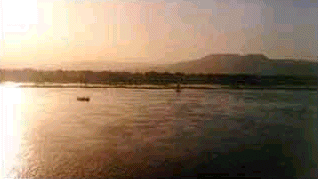
Luxor today is a city of some 150,000 people and is governed by special
statues that allow it more autonomy then other political areas of Egypt.
One thing you might notice is that various government and other buildings
confirm to an 'ancient' building code. Particularly, the National bank of
Egypt (located near the winter palace), the spa south of the police
station, and the railway station are all designed to appear as pharaonic
constructs. All of this occurred after the Egyptianization of the modern
town resulting mostly from the mania that resulted from Howard Carter's
discovery of the Tomb of Tutankhamun. As one might think, the city has all
the amenities tourists might expect, including a variety of hotels, bars,
nightclubs and restaurants.
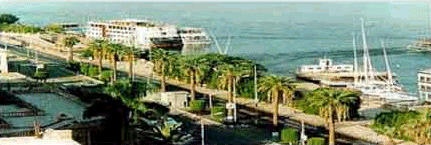
In Luxor proper on the East Bank, one of the first stops must be the
Temple of Luxor built by Amenophis III. Head south on Sharia al-Karnak to
reach the temple, which was connected to the Karnak Temple via a long
stone processional street called a dromos. The dromos (Picture at right)
was built by Nectanebo I, and originally was lined on either side by
sphinxes. In front of the Luxor temple, the dromos is well preserved, and
on the way to the entrance one passes by a Roman chapel of burnt brick
dedicated to the god Serapis, which was built during the rule of Hadrian.
There is a path that leads to the Nile side of the Temple where one enters
the complex.
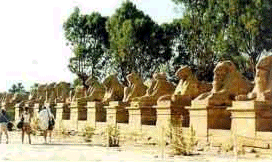
After leaving Luxor, head back to Sharia al-Karnak and go north towards
Karnak. Down the road, near the police station which is near the tomb is
the oldest mosque in Luxor, the El-Mekashkesh Mosque. It contains the
remains of a 10th century Islamic saint who rumor has it was a monk prior
to converting to Islam. The mosque is a popular pilgrimage destination.
Here also is the Franciscan Church and its schools, one for boys and the
other girls. Beyond this lies a great Coptic basilica.
At the Police station, head towards the Nile Corniche. Here, opposite
the Mina Palace Hotel you will find the Mummification Museum, which has
most anything you would ever want to know about mummifications. From here,
head north towards Karnak.
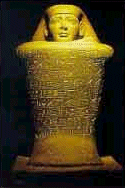
About halfway to Karnak, you will discover the Luxor Museum. (The image
at left is a Block Statue of Iamu Negh from the Luxor Museum). It should
certainly be visited if you plan a well rounded and educated experience.
While this is a small museum, most of the relics are from the surrounding
area and provide considerable insight to the monuments you will visit.
From the Museum, head back to Sharia al-Karnak and continue north towards
Karnak. After crossing a small bridge one will begin to see the excavated
dromos off the road and running through a small village. A little further
on you will pass the ruins of the Temple of Mut where another dromos leads
to the gateway of the tenth pylon. The road finally arrives at the domed
tombs of two saints, Sidi Ahmed and Sidi Ali, where a road leads past the
Department of Antiquities leads to the main Temple of Karnak entrance.
This road is built along a canal that once connected the Nile to the
Temple. There was a dock in ancient times, but now all that is left is the
quay and the raised dais. Just past that is a red brick Roman dock and
past that two paved ramps led to the river bank. They are bordered by
stone parapets, and were built during the rule of Taharqa. Past these is
the Chapel of Achoris, which received the sacred boat of Amun when it was
used in ceremonies.
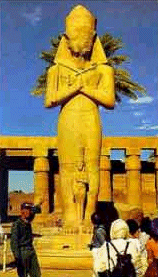
To arrive at the entrance one follows the dromos with its crio-sphinxes.
They have the head of a Ram and the body of a lion and are symbolic of the
God Amun. Arriving at the temple, there is a statue of Ramesses II with
his son between his feet. To the right is a structure that has red steps,
a red front colonnade and red brick walls. Inside there are pedestals.
inscribed with the names of Roman emperors, that once held their statues.
This was a Roman chapel dedicated to imperial worship. After leaving the
Temple complex on the left is the Franco-Egyptian Center which has managed
the temple complex since 1967. Down on the shore of the Nile is the Centre
National dl la Recherche Scientifque, or CNRS, which houses the French and
the Chicago House, a project of the University of Chicago is near by.
After this, you will wish to take a boat trip over to the West bank. This
trip had a special meaning to the Egyptians, for they were more crossing
the way to the West and life, then to a necropolis. The Valley of the
Kings is as good as any to try first, with tombs from the 18th and 19th
Dynasties. Outside the Valley of the Kings, the road leads past Antef,
named for the 11th Dynasty prices who were buried here. Some tombs can
still be seen as one heads towards the Temple of Seti I. Most of what is
left of Seti's Temple is the view. The court is entered by the ruined gate
of a pylon The court has what is left of a palace on the south side. The
road continues south passing Dra-Abu el-Naga necropolis.
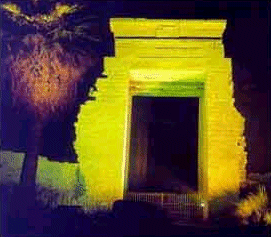

![]()






















